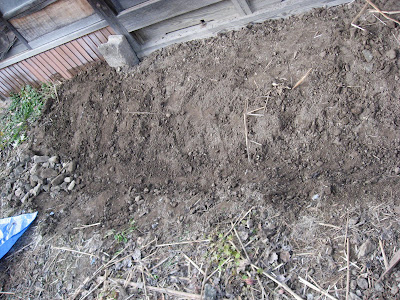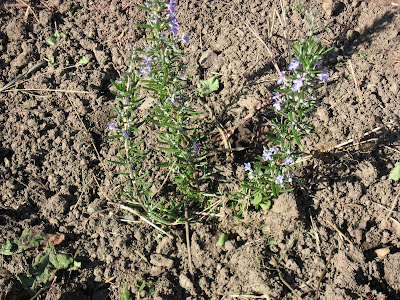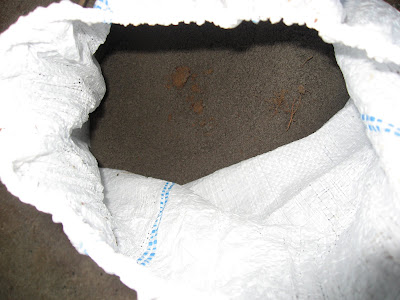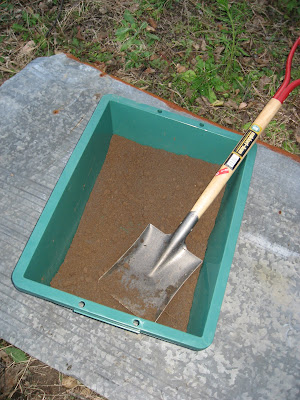Because of the snow, mixing earth plaster didn't seem such a good prospect, so I concentrated on cleaning and cleaning out.
I removed the extremely old tatami mats of the entrance room, as well as the two northerly bedrooms. I also sweeped floors, walls and beams of those rooms with the vacuum cleaner, to remove some of the dust that still lingers.
Again I found two irori hidden under the mats. It seems every room now has an irori except the north western bedroom. This one is in the small room near the entrance. According to the thatcher who I met a few weeks ago, this was used to put in hot coal for a kotatsu, and people would use the room as an everyday living/dining.
Tuesday, 25 December 2007
Tatami removal & cleaning
Posted by
Patrick:
0
comments
![]()
Christmas Surprise
Just before Christmas, I used the long weekend to get some work done at the house. Heading out on Saturday afternoon, I visited one of the locals for tea, and fresh mochi, which his wife prepared in an interesting machine. The next stop was the nearby hot spring, which helped me to recover from the previous night's year end party. Warmed up and relaxed like that, I fell asleep easily.
When I woke up the next morning, a surprise awaited me. The entire landscape has been covered by a 5 cm carpet of fresh white snow!
Posted by
Patrick:
0
comments
![]()
Friday, 21 December 2007
New Web Front for Inaka Home
Now that the cold winter prevents more of the hands-on activities, and as we wait for quotes from contractors to be delivered, I used the time to add a new web page as a front for inaka home.
If you followed this blog from the start or know us personally, perhaps you will find nothing new on the page. However, from now on we will try to add more structured content on this site, and of course add the reservation system once the house is complete.
Please let me know how you like the design and content - your feedback will help to make our site better!
You can find it at http://www.inakahome.com
Have some nice holidays!
Posted by
Patrick:
0
comments
![]()
Labels: web site
Monday, 10 December 2007
A weekend of little work
Last weekend I could not manage to come before late Saturday evening, as I was part of a panel at the Tsukuba University Open Day. I arrived after dark, so only had time to buy some supplies for breakfast and head to the Onsen.
I met the local carpenter on Sunday, and Tomo managed to pop round at the same time. Before that, I used the fresh morning air to dig a trench in front of the house. I plan to put a drainage pipe to carry the run-off water from the roof clear from the woodwork of the house. 
I placed a few large pebbles where the water normally drips down, to break the fall and avoid the splashing.
So overall not much (physical)work this weekend.
Doing business in Inaka
Several weeks before I made friends with one local gentleman, whom I explained about our ideas of fixing the house. Besides helping me to understand the village better, as well as receive more background about my neighbours, and the previous owner's history, it was very useful in finding craftsmen for the job at hand.
Thanks to his great effort, I was introduced to a local thatcher who is going to make us a new roof, and this weekend I was being introduced to the village's carpenter.
Business in the countryside is quite different than in the city. You first sit down near the irori. Then you drink tea/cofee and maybe eat a mikan orange or sweet. You are introduced to each other, including school history, and great achievements, plans for the future, and keep chatting about various things. Finally the issue at hand is tackled, and its decided what needs to be done. In a simple case its decided, and agreed straight away.
Because everyone knows everyone in the village, trust is the most important thing to maintain. No trades men can cheat any villager, otherwise everyone will know and stop doing business. Therefore locally better price can be obtained, than using outside companies. In fact, local people highly distrust outsiders who offer service, particularly if its competing with local service.
For Inaka Home, we must be careful to also respect this trust and honour based system. We have received courtesy and trust already, so we must show ourselves worthy of it. Of course, at the same time we must be wary, that we do not have a conflict with our mission.
Posted by
Patrick:
0
comments
![]()
Monday, 26 November 2007
Birds of Prey and Moonrise
Living in the country side is a very nice experience. Waiting at the traffic light running and errant, I saw this fellow scanning the fields for tasty mice and other snacks:


On our way home, we saw an incredible moon rise. Its difficult to capture with a compact camera. A large round moon came up from the hills to the east:
It was even more enjoyable to watch the moon from the hot bath of the local onsen!
Posted by
Patrick:
0
comments
![]()
Starting Cultivation
I also made a start on our fields. We need to plant a crop that does not require a lot of attention, and can easily be harvested. Ideally we can use it in the kitchen during our stays. Therefore I planted three Rosemary plants in front of the entrance.

My wife and daughter also became active by planting a set of tulips, to welcome visitors in spring and summer.
Posted by
Patrick:
0
comments
![]()
Patching up cracks
As mentioned before the house has many openings which allows both wasps and wind to enter the house. Most of the problem seems to be caused by shrinkage in the wall's mortar mix. According to my study on the subject, either clay or water content was too high. Some of the shrinkage is up to 2cm.
This photo shows the sky seen through the gaps in the wall from the inside.
I bought some sand at a local DIY shop, and mixed it with the soil sample I took from the forest earlier. Than I added some straw from my September weed-battle.
Sand:
Soil with high clay content:
Mixed together:
I added the straw from the back to make it stickier.
As the mixture was ready, I deployed it in the North Eastern bed room to seal the cracks. With a small trowel, I pushed and pressed the mix into the gaps, smoothing it at the end.
Its not pretty at this stage, but it does the job, and later on a beautiful surface layer will be apllied over this rough layer anyway.
Posted by
Patrick:
0
comments
![]()
Searching the Forest
This is a late post of the previous weekend. I headed out early Saturday, and arrived around 8 o' clock the ground and fields were covered by morning frost, which provided a nice contrast to the clear blue sky.
Tired from driving, I headed out into the forest to search for possible building materials. The little stream going past our house leads up into to the forest, and on its banks I found a patch of strong bamboo poles growing. I went deeper into forest, and checked out the earth on the steeper river banks. At one place I spotted some slightly red coloured earth. After scratching off the top layer of decaying leaves, insects and other organic matter, I grabbed a handful of slightly moist dirt, an shaped it into a ball. It had excellent cohesive properties, which led me to believe that the soil has a high clay content.
When walking here you have to be careful, and better stay on the path. Farmers have marked off some areas with plastic ribbons, where they cultivate mushrooms (matsutake or something like that). They won't be happy if heavy boots would crush their crop.
Near the path I found some kind of grass that looked long and solid enough to be used , for example inside walls, as insulating infill or to provide a lattice for mud and plaster to stick on. I cut a few stalks as sample and took them with me to dry them out in the sun. Later I found out they were actually kind of baby bamboo sticks.
Later I went back and picked up another sample of earth from a different place. It didn't look quite as suitable as the previous one, but I tried out a mix all the same.
Posted by
Patrick:
0
comments
![]()
Labels: bamboo, clay, earth quake, forest, sampling
Tuesday, 13 November 2007
Fighting the cold
With the coming of autumn, the temperature inside and outside the house has dropped considerably. Presently we have neither insulation, nor adequate heating system in place, but yet sleep in the house during our work weekends. How can we survive?
We activated one of the fire places in the main room, called irori that I mentioned previously in "Hidden Secrets revealed". While it looks cozy and burns pretty good, it doesn't actually give off much heat and most of that goes up into the air. But as our only heatsource, we can survive by sitting close enough to it.
We also used a table bar-b-q called conro, both for additional heat and for cooking. A tasty cheese and ham omlette in the morning gives enough energy for a days work!
Not all work is physical. Here Tomo enters details of our discussions with contractors, while sitting close for warmth. We use the conro to heat the water in the kettle, so we can also drink hot cofee. I admit its not exactly Starbucks, but very vitalising nonetheless.
Danger ! - Wasp Hives
At the moment the many cracks and holes in the wall makes it easy for unwelcome guests to enter the house. Besides smaller (2cm) hives, we also found to massive ones made by "Suzume-batchi" (info page: Japanese original | English Translation by Google).
Considering that this kind of wasp has an extremely strong poison, we were very reluctant to approach them - however, after some time of observation we concluded that both are deserted, and hence proceded to remove them.
Unfortunately the location of them was rather awkwardly located above the bathroom and toilet, in the eastern (lower roof) part of the house. Because the ceiling is made only by thin veneer sheets, it does not carry weight. A further annoyance was the large amount of dust on top the ceiling...
Nevertheless, Tomo and I tackled this challenge too. After putting on dust mask and googles, I climbed up and balanced on the structural beams to get close. I then shifted a plastic sheet below the hive with attached rope. Tomo handed me various sharp implements, and I sawed off the nest at its based, upon which it fell onto the sheet. By pulling the rope we closed the sheet and pulled it back to the ladder.
On this photo I just nudge the nest with a bamboo pole after making an incision at the top.
The reward of the hard work, the heroes of an epic battle:
Looking closer at the hives, reveals amazing and fascinating construction:
Posted by
Patrick:
0
comments
![]()
Kitchen Stripping part 2
If you remember the previous post "Naked Kitchen" , we want to lower the kitchen to ground level and have polished concrete or tile flooring.
This time I used the second pair of hands to move the kitchen sink out temporarily. Tomo checked the beam structure holding up the bathroom and toilet, and advised which could be cut.
So first we ripped out remaining floor boards and wooden wall frames, then I attacked the beams with the Chainsaw.
One beam extended far into the room and held up the bathroom. So before sawing it off, I supported it with the jack from the rental car, then slipped in a piece of wood that I cut to 16.5 cm. After lowering the thus supported beam again, it was safe to remove the protruding bit. On the very right of this photo you can see the new piece of wood.
Did I mention rubbish? Yes I did. I removed another two large bags of rubbish and polluted soil together with Mori-san.
Job well done. All beams and posts removed, we can now contemplate working on the kitchen for real. The sliding doors at the back will be replaced with a structural wall. The window at the rear of the room may be removed, and all walls need fixing. For the moment we put the sink back so that we can use indoors water during the construction period. The fireplace can also be left for a while, maybe we can use it for warming our fingers during winter reconstruction.
Posted by
Patrick:
0
comments
![]()
Monday, 12 November 2007
Autumn has arrived
Even though according to the Japanese traditional calendar its is already winter, It looks more like Autumn in Ueda and surrounding area. Trees wear their colours proudly, and if it was not for the rain showers this would be a brilliant weekend for enjoying nature.
On the other hand we did not come for pleasure, but to work on the house. Tomo brought one of his staff, Mori-san, who kindly volunteered to help us.
The straw roof is very beautiful in rain, and this time I even spotted a patch of green vegetation growing on it.
This weekend several constructors were scheduled to visit the house, inspect the situation and prepare quotations. Even though we want to do the repairs as much as possible on our own, some jobs need expert attention. We had an interesting selection of local tradesmen, ranging from a company specialising on repairing temples and shrines, to some who deal with Minka and one who do eco-friendly/natural building. We also had a guy over to check whether we can install a modern wood stove to heat the main room. One of them remains strongly in memory, thanks to his fantastic business card:

It looks exactly like him!
Posted by
Patrick:
0
comments
![]()
Labels: autumn, contractors
Monday, 8 October 2007
Mud-wall recycling experiment
Oh whats that? A palm sized hole in the kitchen wall!
We aim to use mostly natural building materials, both to be sustainable and also to save cost. So from last weekend works efforts there remains a pile of mud wall, ready mixed:
I put a few shovel ful into a bucket and added water. it took a little experimenting to get the right relation of water vs mud straw mixture. The key point is that the small shovel should remain standing on its own when stabbed into the mix. At first I had too much water - the thing kept standing but when applied the mixture just ran away. Add more mud.
This is the wall from the outside after completing the inside patch. Before slamming on the mud mix, I placed two bamboo sticks and chicken wire in the middle.
This is how it looks from the inside:
It worked so well that I took on huge gaps above the windows in the south wall. Again placed some chicken wire and then scooped on th mud-mix. Wasps, hornets and spiders - fare well!
Nice work:
Naked kitchen
Tackling the kitchen required some of the same skills and techniques used on the other rooms to remove the ceiling. Because it was relatively low, I had no problem getting it out.
However, in this room walls were wood paneled and covered with disgusting layers of cooking fat, oil and grease. There was no other way, they had to go too. Because the kitchen had a very low ceiling, we want to put it down onto ground level, and just finish the floor with concrete, like the entrance area. So I also had to remove the (ugly) wooden flooring.
The kitchen stripped (nearly) naked:
It appeared that the walls to the outside were made up of the the thinnest possible material, then an empty space, then the paneling. Because the outside is riddled with many cracks and holes, those cavities provide excellent habitats for bees and wasps... definetly have to do something about them! An internal wall was made with a gypsum plate.
Removing the floor paneling revealed another fire place. A second layer of weight carrying boards was revealed. Below those, a collection of old beams and provided a fixing place. I couldn't move the sink on my own, so it has to go some other time. In the mean time I used the CHAINSAW, to reveal the ground just in front of it. Getting the floor boards up is quite a job because so many nails are used.
The previous owner left a surprise for me: Below the floor boards - a load of rubbish!
As I took this photo I already filled two garbage bags with the thrash. I found some evidence of small mamal habitation, but judging by tiny skelletons and absence of food, they are long gone.
There is still some rubbish to be cleared next time:
Posted by
Patrick:
0
comments
![]()
Labels: ceiling, chainsaw, floor board, kitchen, mice, rubbish, thrash, wall panels

